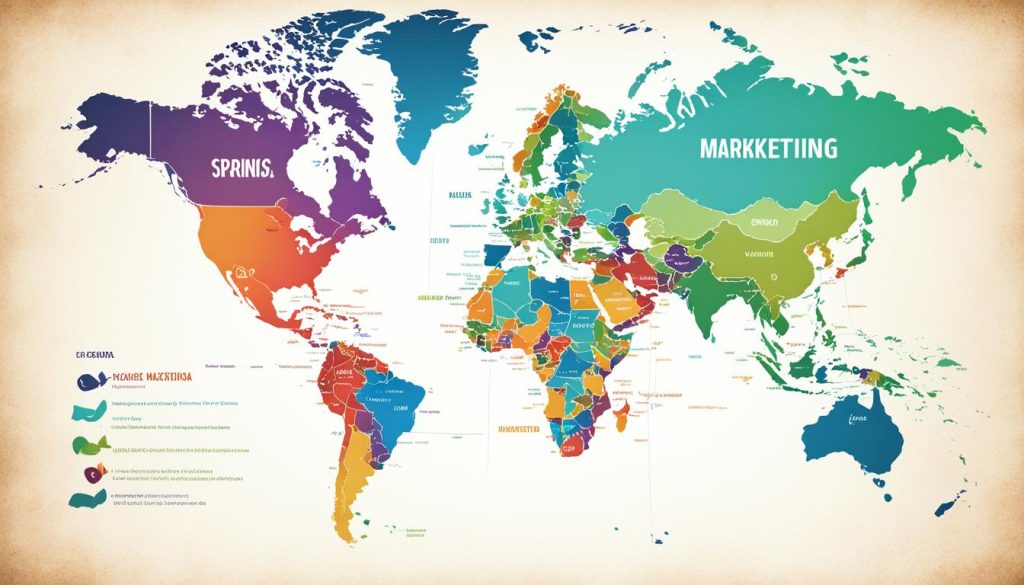Welcome to our guide on crafting a successful global marketing plan. In today’s world, businesses can reach out to customers worldwide. But, to succeed globally, you need careful planning and smart strategies. This article offers tips and strategies. These are aimed to create a marketing plan that connects with your audience and brings results.
A strong global marketing plan begins with a solid strategy. This strategy considers cultural differences, various languages, and local traditions. It makes sure your products or services and messages speak to people all over the world. By building a strong global brand and targeting your marketing, you can really grab your audience’s attention.
In this article, we’ll touch on different parts of marketing globally. This includes knowing your target market, doing a SWOT analysis, setting your budget, and choosing your marketing methods. We’ll also talk about why it’s vital to put your plan into action. And, monitoring how well it does, tweaking as needed based on data and analytics.
If you’re a small business going into international markets or a big company wanting to widen your global influence, this guide is for you. It has insights and tips to better your global marketing. Let’s get started and learn how to create a marketing plan that works all around the world!
How Does Strategy Impact Global Marketing Success?
Strategy is key in global marketing success. It focuses on cultural differences, languages, currency, and local customs. This approach helps businesses make strategies that work for their audience’s needs and preferences.
A good strategy can bring many benefits. It can make entering new markets easier, reduce customer costs, increase brand recognition, and help grow into new areas. By aligning strategies with what local markets want, businesses lay a strong base for global success.
Key Factors to Consider in Global Marketing Strategy:
- Cultural Nuances: Tailoring marketing to cultural differences helps connect with vast audiences.
- Language Differences: Using local languages leads to better communication with customers.
- Currency Conversions: Knowing how to price in different markets is crucial for competitiveness.
- Local Customs: Including local customs in marketing builds trust with customers.
Integrating these factors into strategies is crucial. It ensures marketing is focused on meeting each market’s unique needs. This makes the approach more effective and meaningful.
10 Tips for Effective Global Marketing Strategy
Creating a successful global marketing strategy takes time and thought. You need to think about many things to get the best results. Here are ten tips that all companies aiming at the global market should use:
- Establish clear business goals: Begin by setting clear objectives for your international marketing. Know what you want to do and how you’ll decide if you have succeeded. This is important for focusing your efforts the right way.
- Prioritize audience research: Research your target market well. Understand what they like, need, and how they act. This knowledge will guide you in making your messages and products or services fit their needs better.
- Build streamlined branding: Create a brand identity that connects with people worldwide. Make sure your brand messages and values are the same everywhere. Also, think about cultural differences and local practices when you do this.
- Simplify campaigns: Make sure your marketing efforts are simple and clear. Don’t confuse your customers with too much information. Focus on what really matters and make sure it’s easy to understand and interesting for them.
- Invest in multi-lingual SEO: Make your online content easily accessible in different languages. This is done through SEO (search engine optimisation). Doing this helps more people find you online. It makes your global presence stronger.
- Use social media across markets: Social media can be a powerful tool in reaching your global audience. Create strategies that are specific to each market. Think about the local culture and what people like there.
- Repurpose content: Adjust your content to fit each new market and language. This way, you can connect better with local audiences while keeping your brand’s core messages consistent. It saves you time and effort, too.
- Customize channel selection: Choose where to market your brand wisely. Pick the best places based on how your audience in each market behaves and what they like. This includes both online and traditional ways of reaching people.
- Build local partnerships: Working with local businesses and influencers can make a big difference. It helps you understand the new market and earn the trust of its people. It’s a good way to break cultural barriers, too.
- Focus on customer-centric translation and localization: Make sure your messages and content are right for each new market. Translate and adapt your content well. This makes your stuff more attractive and interesting to locals.
By integrating these tips into your marketing approach, you can create a strategy that really connects with people worldwide. This leads to more interaction and growth in various markets.
Measuring the ROI of Your Global Marketing Efforts
It’s key to check how well your global marketing works. This lets you make smart choices and improve plans. Looking at ROI shows the impact of your work and helps you spend wisely. You should look at certain measures to see how well your global marketing is doing:
1. Conversion Rate
The conversion rate shows how many visitors or leads do what you want. This could be buying something or signing up. It’s important for seeing how effective your campaigns are across different places.
2. Cost Per Acquisition (CPA)
CPA tells you the average cost needed to get a new customer. Looking at CPA in various places and channels can show you where to put more money for better results.
3. Return on Advertising Spend (ROAS)
ROAS tells you the income made for each pound you spend on ads. It shows which ads or platforms are most profitable. This can help you focus your efforts better.
4. Engagement Rate
Engagement rate measures how much your audience interacts with your content. It looks at likes, shares, and comments. This shows how well your marketing grabs your audience’s attention.
5. Click-through Rate (CTR)
CTR shows the proportion of people who click on your link or ad. A high CTR means your message is compelling. This plays a big role in making your marketing efforts successful.
Keeping an eye on these metrics can give you important information about your marketing performance. This information can guide you in making choices, refining strategies, and increasing the ROI of your marketing around the world.
Examples of Global Brand Marketing Success
Global brands succeed by personalizing products, creating tailored content, and partnering with local businesses. They resonate with their audience through strong local presence. Let’s look at some global brand marketing success stories.
Coca-Cola
Coca-Cola is famous for its global marketing wins. They make ads that spread happiness and bring people together worldwide. Their Christmas ads and FIFA World Cup sponsorships are key examples.
McDonald’s
McDonald’s is doing well in the marketing game too. They change their menus to fit local tastes. Their marketing targets specific groups and cultural aspects, helping them succeed in various markets.
Nike
Nike is a leader in global marketing. They work with top athletes and sponsor sports events to tie their brand to success. By being consistent in their messaging, they’ve become a global symbol of aspiration.
To craft a global brand strategy, understanding local culture is key. By adapting products and content, and forming the right partnerships, businesses can connect with their audience deeply.
Understand Your Target Market
To make a great international marketing plan, knowing your target market is key. You need to find out who your ideal customers are. Then, you can make your marketing hit the right note. This will help you do well in foreign markets.
You learn a lot from market research. Stuff like their age, gender, where they live, how much they earn, and what they buy is crucial. Getting this info lets you split your market into groups. After that, you can make marketing plans that really speak to each group.
Key Considerations for Understanding Your Target Market:
- Demographics: Understand who your target market is, like their age and where they live. This helps you make messages that really appeal to them.
- Interests: Find out what your target audience likes to do. This info is gold. It lets you make content that they’ll find interesting and which speaks to their values.
- Pain Points: Know the problems your customers face. If your marketing shows your product can help, it’s more likely to sell.
Knowing your market inside out means you can make marketing plans that work. This might mean using digital tools like social media ads. Or maybe content marketing is best for reaching them where they are.
Always put your ideal customer at the centre of your plans. If your marketing meets their needs and wants, you’ll attract them. And you’ll build strong, lasting relationships with them.
Develop a SWOT Analysis
To succeed internationally, you must do a full SWOT analysis. This analysis spots what your company is good and bad at. It also looks at the chances and dangers in the market. Knowing these helps you make smart moves and plan strong marketing.
Analyzing Strengths
It’s key to find and use what your company is good at. This might be unique products, a good brand, amazing service, or special market knowledge. Using these areas well helps you stand out and succeed overseas.
Evaluating Weaknesses
But, it’s also vital to see your company’s weak spots. This could be not much money, little known in other places, or product problems. Fixing these helps make your marketing overseas work better and safer.
Seizing Opportunities
The big wins often come from new chances in the world market. This can be new places to sell, changes in what people want, or new tech. Spotting and grabbing these chances helps your company sell more and become bigger around the world.
Mitigating Threats
There are always risks, like tough competition or sudden laws. Knowing and dealing with these dangers helps you make plans that work. It keeps your company strong and smart in the world market.
To wrap up, a SWOT analysis is key for strong international marketing. It shows what your company is great and not-so-great at. It also tells you what the world market offers and what can go wrong. Using this info right helps your company do well in the global market.
Determine Your Marketing Budget
When crafting an international marketing strategy, a key part is figuring out your budget. A realistic budget means you’ll have enough money to do your marketing well. This helps you meet your goals.
Think about the costs when choosing your marketing budget. You must include money for ads. This means paying to advertise on places like social media and search engines. Find which platforms work best for your audience and spend money wisely there.
Creating content is another big expense. Making stuff that speaks to people around the world needs good writers, designers, and photographers. Blog posts, videos, or infographics, they all need to be top-notch to catch your target’s eye.
Social media is crucial for your marketing plan. You should be strong on various platforms. This means having good posts, managing your online community, and running ad campaigns.
Don’t forget about tools like email marketing software and SEO software. These are vital for checking how your marketing is doing, understanding the numbers, and making smart choices.
By carefully choosing where your money goes, you’ll have a solid budget for your global marketing. A good budget lets you put your strategy in motion and see if it’s working well.
Plan Your Marketing Channels and Strategies
When making an international marketing plan, the first thing to think about is which channels and strategies will work best. You want to reach your target audience and meet your goals. By picking the right channels and having clear strategies, you can make a big impact and find success in global markets.
Choose the Right Marketing Channels
It’s essential to pick the best channels to reach your audience. Using digital channels like social media, email, and SEO can connect you with people worldwide. Traditional methods, such as print and events, are still valuable for local markets or specific groups. Look at your audience’s habits and preferences to choose wisely.
Develop Consistent Strategies
Having a strong and consistent strategy across all channels is crucial. Make sure your plans match your marketing goals and who you’re aiming at. Adjust your messages for each market’s culture and language. This helps to build trust, make your brand stand out, and get people involved.
Implement Localization
Adapting your marketing to fit different places and cultures is essential. This means more than just translating content. It includes understanding local customs, social norms, and what customers like. When you can speak to people in a way that feels personal, you build stronger relationships.
Utilize Data and Analytics
Tracking data is key to see if your efforts are paying off. Watch things like website visits, how many people buy from you, and social media involvement. This info helps you see what’s working and what’s not. Then, you can make your marketing even better over time.
Plan your marketing well, keeping your audience and goals in mind. Make sure your message fits each market, stay the same across all channels, and use data to improve. With a strong international marketing plan, you can draw in your audience, boost brand visibility, and meet your goals.
Implement and Monitor Your Plan
After creating a detailed marketing plan, the work is not over. Now, it’s time to put your strategies into action. This is the critical phase. You will work on making sure your marketing ideas reach the right people well.
It’s vital to keep an eye on how well your plan is doing. Watch closely using KPIs to see what’s working and what’s not. By analysing these figures, you can tweak your efforts for better results.
Here are some top tips for getting your plan up and running smoothly:
- Assign responsibilities: Make sure everyone in your team knows what part they play. This will help your plan run like clockwork.
- Set achievable goals: Choose goals that are clear, measurable, and doable. This will guide you throughout the project.
- Create a timeline: A well-planned schedule with deadlines is crucial. It keeps things moving and on time.
- Allocate resources: Work out what you need in terms of budget, people, and tech to get the job done.
- Leverage analytics tools: Use tools like Google Analytics to understand how your campaigns are doing. This can guide your next steps.
- Regularly review and optimize: Keep an eye on what’s happening. Adjust your plan as needed to get the best results.
By putting your marketing tactics into motion and checking their progress, you can meet your goals. Reviewing and enhancing your strategies based on what the data tells you can keep you at the top of your game.
Adjust Strategies Based on Performance
Checking how well your marketing strategies work is key to getting the best results. By keeping an eye on how things perform and making changes, you can outshine others in a busy market.
Looking at data and using analytics helps you see where you can do better. It lets you tweak your plans, improving your marketing. This all leads to achieving better results.
Key Steps for Strategy Adjustment:
- Evaluate Key Performance Indicators (KPIs) – Analyze metrics such as website traffic, conversion rates, and customer engagement.
- Identify Areas for Improvement – Figure out which strategies aren’t working well and why.
- Explore New Opportunities – Seek out new trends or market areas that fit your goals.
- Experiment with A/B Testing – Try different messages, creative work, or marketing ways to see what your audience likes most.
- Optimize Budget Allocation – Check your marketing budget and move funds to what works best.
Keep an eye on how your marketing plans do and adjust them based on what’s working. With a flexible approach and decisions based on data, you can really make your marketing efforts count. This is vital for winning in a constantly changing business world.
Utilize Automation Tools
Automation tools are key for making marketing smoother, saving both time and money. They help businesses tweak their marketing plans to better reach the right people. Top tools you might use include:
Email Marketing Platforms
Email marketing platforms make sending out emails easier. They let you send messages that feel personal and meet the needs of different groups. Plus, they track what works best so you can improve your emails over time. This can boost how often customers interact with you and the results you see.
Customer Relationship Management (CRM) Systems
CRM systems are like a big, neat book for keeping all your customer info in one place. Perfect for staying on top of who’s who and what they need. With some smart tools, you can even automate steps to turn leads into happy customers, all while keeping your team in the loop. Making friends and closing deals becomes much smoother this way.
Social Media Management Platforms
Social media platforms help keep your posts on track, watch how people respond, and see the impact. Tackling several social media accounts is a cinch, and so is making sure your message is clear and steady. By using these tools, you can spend more time making your content great and less time worrying about the post schedule.
Analytics Tools
Analytics help you understand where you stand with your marketing and what needs work. They look at who visits your site, how your ads perform, and what people do when they get there. This knowledge can shine a light on what you can do better, help fine-tune your strategies, and ultimately, see more success.
Develop Local Partnerships
Working with local partners is a top way to introduce and enhance brands in overseas markets. By joining hands with local influencers and businesses, brands push their name forward. They also make sure their message finds roots among the locals.
These partnerships bring lots of pluses. There’s more interaction, trust, and respect. Teaming up with local influencers means tapping into their fan base. This elevates the brand’s profile and forges strong links with locals.
Also, connecting with local businesses opens up new doors. It lets brands reach more customers and gain handy market know-how. Together, they can pull off marketing efforts that go farther and make the brand more recognisable.
Allying with locals bridges gaps in culture and language. They offer key knowledge on what matters to the local crowd. This helps brands tweak their approach, making it fit better and feel more welcoming to the intended audience.
So, partnering locally is key for marketing globally. It makes promoting products and services in new places more effective and appealing. And it really helps in speaking the language of the people you want to reach.
Conclusion
Understanding who you’re trying to reach is key in global marketing. Digital marketing is powerful in this age. It’s also important to work closely with local partners. This approach helps strategies connect with many cultures.
Online platforms help businesses expand internationally. But, it’s vital to keep track of how well strategies are working. Adjusting strategies based on their performance is essential for success.
To sum up, following the steps and advice shared here makes managing global marketing easier. It’s crucial to check on marketing often and be ready to change. With a flexible and well-designed plan, any business can grow and succeed worldwide.
FAQ
Q: What is a global marketing plan?
Q: How does strategy impact global marketing success?
Q: What are some tips for creating an effective global marketing strategy?
Q: How do you measure the ROI of global marketing efforts?
Q: Can you provide examples of successful global brand marketing?
Q: Why is it important to understand the target market for international marketing?
Q: What is a SWOT analysis and how does it help in international marketing?
Q: How do you determine a marketing budget for international marketing?
Q: What are some recommended marketing channels for international marketing?
Q: How do you implement and monitor an international marketing plan?
Q: What should you do if your international marketing strategies are not performing well?
Q: How can automation tools benefit international marketing efforts?
Q: How do local partnerships contribute to global marketing success?
Q: How can I craft a successful global marketing plan?
Source Links
- https://www.smartling.com/resources/101/5-ways-to-build-a-powerful-global-marketing-strategy-5-examples/
- https://amasty.com/blog/unlocking-your-international-market-10-tips-to-crafting-an-effective-international-marketing-strategy/
- https://www.linkedin.com/pulse/crafting-successful-marketing-plan-step-by-step-guide-denis-lugalia-ja9rf?trk=article-ssr-frontend-pulse_more-articles_related-content-card











